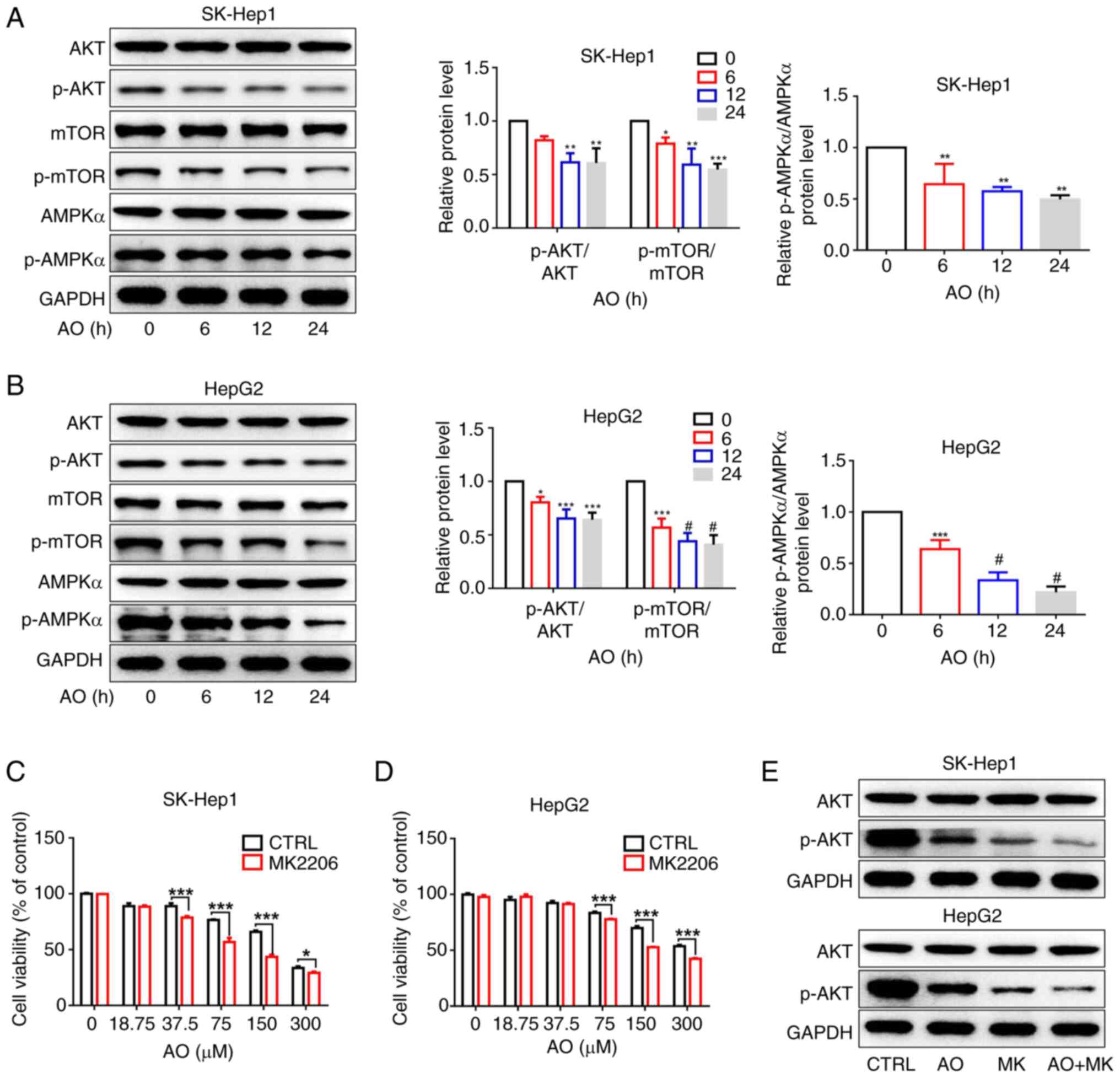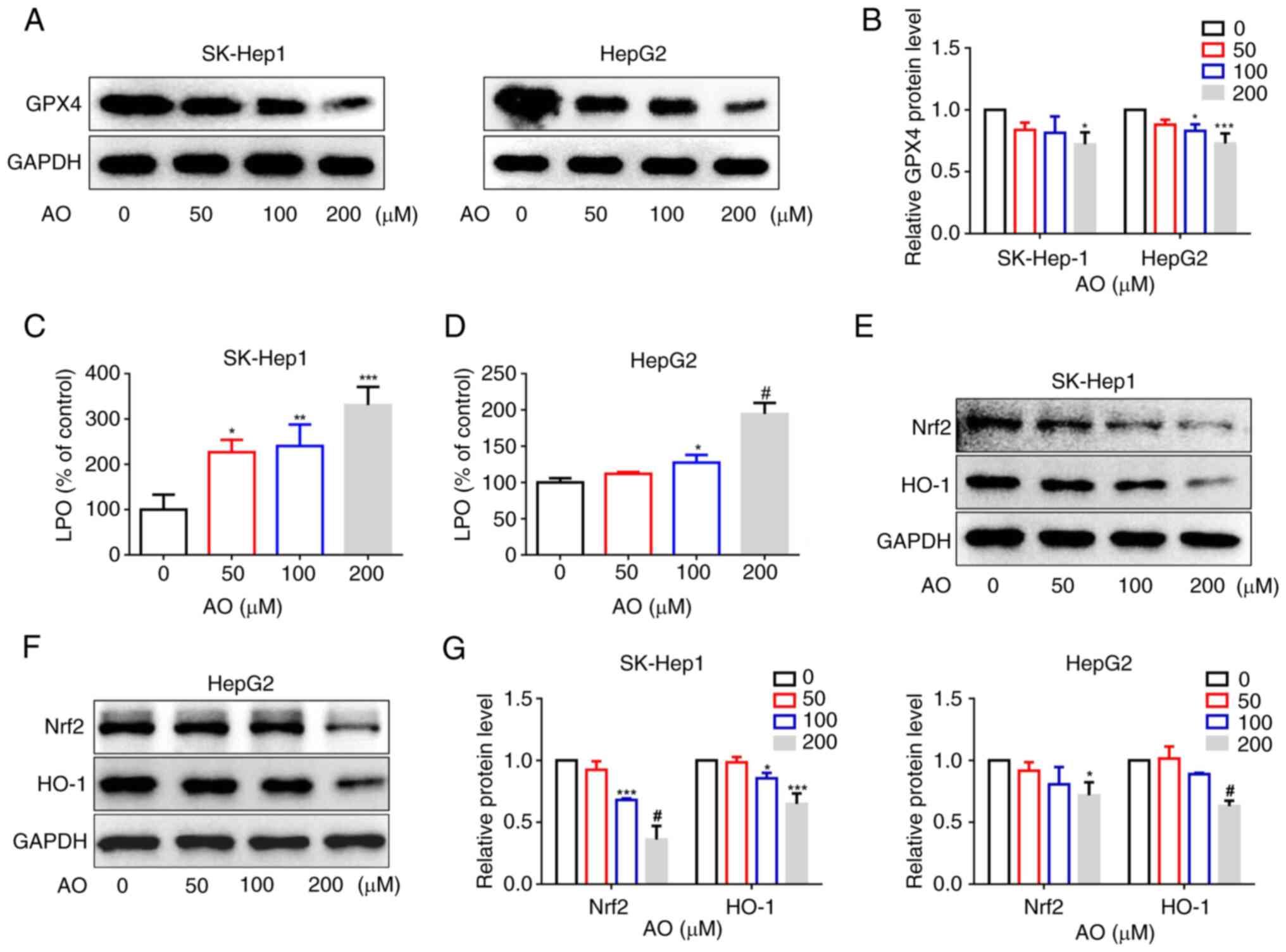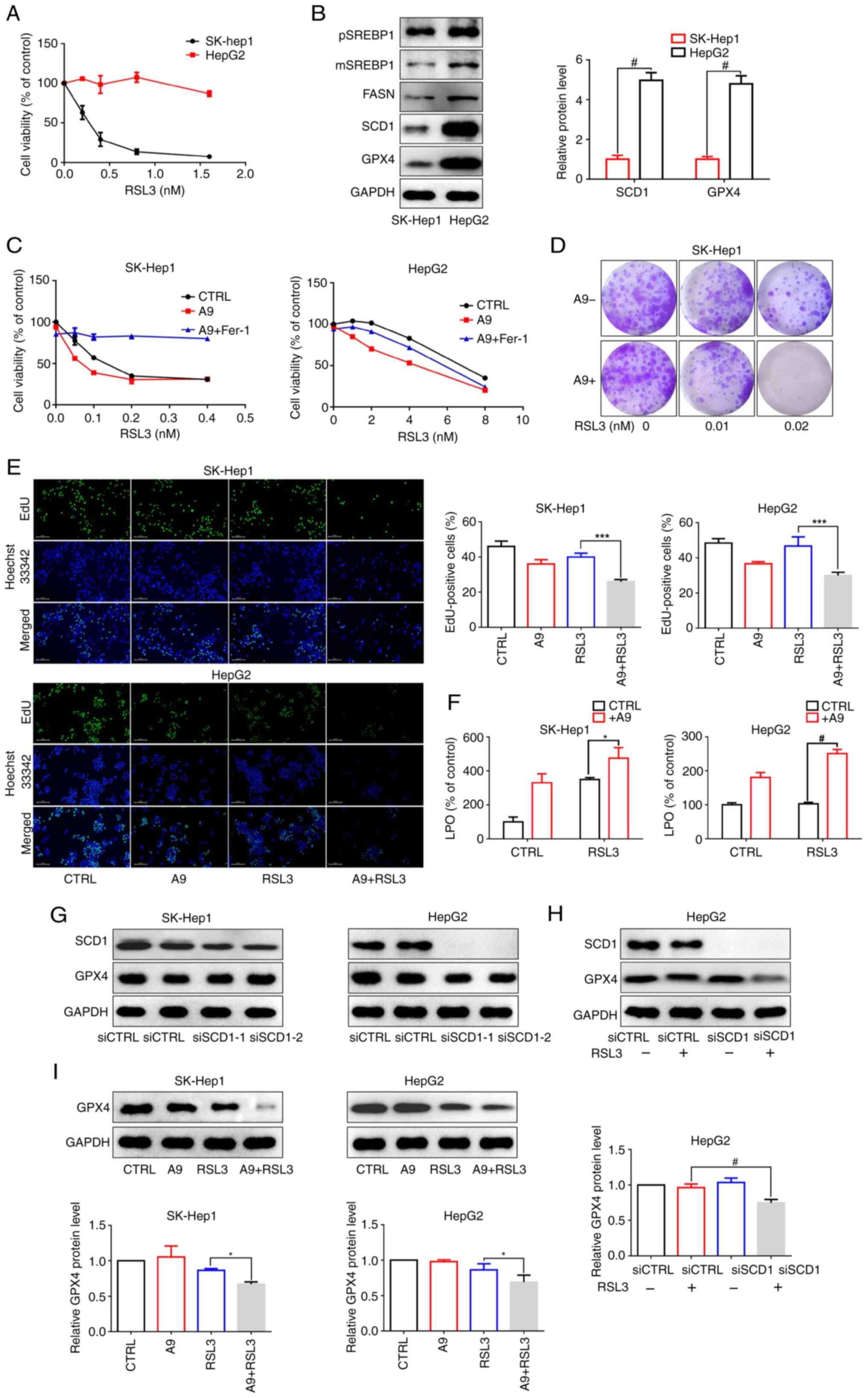|
1
|
Bray F, Ferlay J, Soerjomataram I, Siegel
RL, Torre LA and Jemal A: Global cancer statistics 2018: GLOBOCAN
estimates of incidence and mortality worldwide for 36 cancers in
185 countries. CA Cancer J Clin. 68:394–424. 2018. View Article : Google Scholar : PubMed/NCBI
|
|
2
|
Chen D, Wang J, Li Y, Xu C, Fanzheng M,
Zhang P and Liu L: LncRNA NEAT1 suppresses cellular senescence in
hepatocellular carcinoma via KIF11-dependent repression of CDKN2A.
Clin Transl Med. 13:e14182023. View Article : Google Scholar : PubMed/NCBI
|
|
3
|
Wang L, Liu BX and Long HY: Ablative
strategies for recurrent hepatocellular carcinoma. World J Hepatol.
15:515–524. 2023. View Article : Google Scholar : PubMed/NCBI
|
|
4
|
Aravinthan AD, Bruni SG, Doyle AC, Thein
HH, Goldaracena N, Issachar A, Lilly LB, Selzner N, Bhat M,
Sreeharsha B, et al: Liver transplantation is a preferable
alternative to palliative therapy for selected patients with
advanced hepatocellular carcinoma. Ann Surg Oncol. 24:1843–1851.
2017. View Article : Google Scholar : PubMed/NCBI
|
|
5
|
Shukla A, Patkar S, Sundaram S, Shah SR,
Ingle M, Gupta A, Gopan A, Kamat M, Mohanka R, Singh S, et al:
Clinical profile, patterns of care & adherence to guidelines in
patients with hepatocellular carcinoma: Prospective multi-center
study. J Clin Exp Hepatol. 12:1463–1473. 2022. View Article : Google Scholar : PubMed/NCBI
|
|
6
|
Nakagawa H, Hayata Y, Kawamura S, Yamada
T, Fujiwara N and Koike K: Lipid metabolic reprogramming in
hepatocellular carcinoma. Cancers (Basel). 10:4472018. View Article : Google Scholar : PubMed/NCBI
|
|
7
|
Balsano C, Porcu C, Sideri S and Tavolaro
S: Fat and hepatocellular carcinoma. Hepatoma Res. 4:382018.
View Article : Google Scholar
|
|
8
|
Scheinberg T, Mak B, Butler L, Selth L and
Horvath LG: Targeting lipid metabolism in metastatic prostate
cancer. Ther Adv Med Oncol. 15:175883592311528392023. View Article : Google Scholar : PubMed/NCBI
|
|
9
|
Fhu CW and Ali A: Fatty acid synthase: An
emerging target in cancer. Molecules. 25:39352020. View Article : Google Scholar : PubMed/NCBI
|
|
10
|
Jones SF and Infante JR: Molecular
pathways: Fatty acid synthase. Clin Cancer Res. 21:5434–5438. 2015.
View Article : Google Scholar : PubMed/NCBI
|
|
11
|
Koundouros N and Poulogiannis G:
Reprogramming of fatty acid metabolism in cancer. Br J Cancer.
122:4–22. 2020. View Article : Google Scholar :
|
|
12
|
Qin XY, Su T, Yu W and Kojima S: Lipid
desaturation-associated endoplasmic reticulum stress regulates MYCN
gene expression in hepatocellular carcinoma cells. Cell Death Dis.
11:662020. View Article : Google Scholar : PubMed/NCBI
|
|
13
|
Wang H, Zhou Y, Xu H, Wang X, Zhang Y,
Shang R, O'Farrell M, Roessler S, Sticht C, Stahl A, et al:
Therapeutic efficacy of FASN inhibition in preclinical models of
HCC. Hepatology. 76:951–966. 2022. View Article : Google Scholar : PubMed/NCBI
|
|
14
|
Wang X, Liu Y, Han A, Tang C, Xu R, Feng
L, Yang Y, Chen L and Lin Z: The NQO1/p53/SREBP1 axis promotes
hepatocellular carcinoma progression and metastasis by regulating
Snail stability. Oncogene. 41:5107–5120. 2022. View Article : Google Scholar : PubMed/NCBI
|
|
15
|
Li C, Yang W, Zhang J, Zheng X, Yao Y, Tu
K and Liu Q: SREBP-1 has a prognostic role and contributes to
invasion and metastasis in human hepatocellular carcinoma. Int J
Mol Sci. 15:7124–7138. 2014. View Article : Google Scholar : PubMed/NCBI
|
|
16
|
Shimano H and Sato R: SREBP-regulated
lipid metabolism: Convergent physiology-divergent pathophysiology.
Nat Rev Endocrinol. 13:710–730. 2017. View Article : Google Scholar : PubMed/NCBI
|
|
17
|
Peterson TR, Sengupta SS, Harris TE,
Carmack AE, Kang SA, Balderas E, Guertin DA, Madden KL, Carpenter
AE, Finck BN and Sabatini DM: mTOR complex 1 regulates lipin 1
localization to control the SREBP pathway. Cell. 146:408–420. 2011.
View Article : Google Scholar : PubMed/NCBI
|
|
18
|
Bakan I and Laplante M: Connecting mTORC1
signaling to SREBP-1 activation. Curr Opin Lipidol. 23:226–234.
2012. View Article : Google Scholar : PubMed/NCBI
|
|
19
|
Tao T, Su Q, Xu S, Deng J, Zhou S, Zhuang
Y, Huang Y, He C, He S, Peng M, et al: Down-regulation of PKM2
decreases FASN expression in bladder cancer cells through
AKT/mTOR/SREBP-1c axis. J Cell Physiol. 234:3088–3104. 2019.
View Article : Google Scholar
|
|
20
|
Li Y, Yang W, Zheng Y, Dai W, Ji J, Wu L,
Cheng Z, Zhang J, Li J, Xu X, et al: Targeting fatty acid synthase
modulates sensitivity of hepatocellular carcinoma to sorafenib via
ferroptosis. J Exp Clin Cancer Res. 42:62023. View Article : Google Scholar : PubMed/NCBI
|
|
21
|
Ursini F and Maiorino M: Lipid
peroxidation and ferroptosis: The role of GSH and GPx4. Free Radic
Biol Med. 152:175–185. 2020. View Article : Google Scholar : PubMed/NCBI
|
|
22
|
Wang Z, Zhou C, Zhang Y, Tian X, Wang H,
Wu J and Jiang S: From synergy to resistance: Navigating the
complex relationship between sorafenib and ferroptosis in
hepatocellular carcinoma. Biomed Pharmacother. 170:1160742024.
View Article : Google Scholar
|
|
23
|
Dahiya M and Dureja H: Sorafenib for
hepatocellular carcinoma: Potential molecular targets and
resistance mechanisms. J Chemother. 34:286–301. 2022. View Article : Google Scholar
|
|
24
|
Wang C, Zheng C, Wang H, Shui S, Jin H,
Liu G, Xu F, Liu Z, Zhang L, Sun D and Xu P: Dual degradation
mechanism of GPX4 degrader in induction of ferroptosis exerting
anti-resistant tumor effect. Eur J Med Chem. 247:1150722023.
View Article : Google Scholar : PubMed/NCBI
|
|
25
|
Tang W, Chen Z, Zhang W, Cheng Y, Zhang B,
Wu F, Wang Q, Wang S, Rong D, Reiter FP, et al: The mechanisms of
sorafenib resistance in hepatocellular carcinoma: Theoretical basis
and therapeutic aspects. Signal Transduct Target Ther. 5:872020.
View Article : Google Scholar : PubMed/NCBI
|
|
26
|
Gao Z, Wang D, Yang J, Li M, Ling C, Lv D,
Cao Y, Chen Z, Shi C, Shen H and Tang Y: Iron deficiency in
hepatocellular carcinoma cells induced sorafenib resistance by
upregulating HIF-1α to inhibit apoptosis. Biomed Pharmacother.
163:1147502023. View Article : Google Scholar
|
|
27
|
Menendez JA and Lupu R: Fatty acid
synthase and the lipogenic phenotype in cancer pathogenesis. Nat
Rev Cancer. 7:763–777. 2007. View Article : Google Scholar : PubMed/NCBI
|
|
28
|
Raeisi M, Hassanbeigi L, Khalili F,
Kharrati-Shishavan H, Yousefi M and Mehdizadeh A: Stearoyl-CoA
desaturase 1 as a therapeutic target for cancer: A focus on
hepatocellular carcinoma. Mol Biol Rep. 49:8871–8882. 2022.
View Article : Google Scholar : PubMed/NCBI
|
|
29
|
Guo Z, Huo X, Li X, Jiang C and Xue L:
Advances in regulation and function of stearoyl-CoA desaturase 1 in
cancer, from bench to bed. Sci China Life Sci. 66:2773–2785. 2023.
View Article : Google Scholar : PubMed/NCBI
|
|
30
|
Sen U, Coleman C and Sen T: Stearoyl
coenzyme A desaturase-1: Multitasker in cancer, metabolism, and
ferroptosis. Trends Cancer. 9:480–489. 2023. View Article : Google Scholar : PubMed/NCBI
|
|
31
|
Liu HH, Xu Y, Li CJ, Hsu SJ, Lin XH, Zhang
R, Chen J, Chen J, Gao DM, Cui JF, et al: An SCD1-dependent
mechanoresponsive pathway promotes HCC invasion and metastasis
through lipid metabolic reprogramming. Mol Ther. 30:2554–2567.
2022. View Article : Google Scholar : PubMed/NCBI
|
|
32
|
Bansal S, Berk M, Alkhouri N, Partrick DA,
Fung JJ and Feldstein A: Stearoyl-CoA desaturase plays an important
role in proliferation and chemoresistance in human hepatocellular
carcinoma. J Surg Res. 186:29–38. 2014. View Article : Google Scholar :
|
|
33
|
Wang C, Shi M, Ji J, Cai Q, Zhao Q, Jiang
J, Liu J, Zhang H, Zhu Z and Zhang J: Stearoyl-CoA desaturase 1
(SCD1) facilitates the growth and anti-ferroptosis of gastric
cancer cells and predicts poor prognosis of gastric cancer. Aging
(Albany NY). 12:15374–15391. 2020. View Article : Google Scholar : PubMed/NCBI
|
|
34
|
Tesfay L, Paul BT, Konstorum A, Deng Z,
Cox AO, Lee J, Furdui CM, Hegde P, Torti FM and Torti SV:
Stearoyl-CoA desaturase 1 protects ovarian cancer cells from
ferroptotic cell death. Cancer Res. 79:5355–5366. 2019. View Article : Google Scholar : PubMed/NCBI
|
|
35
|
Yang WS and Stockwell BR: Ferroptosis:
Death by lipid peroxidation. Trends Cell Biol. 26:165–176. 2016.
View Article : Google Scholar :
|
|
36
|
Chen H, Qi Q, Wu N, Wang Y, Feng Q, Jin R
and Jiang L: Aspirin promotes RSL3-induced ferroptosis by
suppressing mTOR/SREBP-1/SCD1-mediated lipogenesis in PIK3CA-mutant
colorectal cancer. Redox Biol. 55:1024262022. View Article : Google Scholar : PubMed/NCBI
|
|
37
|
Kim M, Lim SJ, Lee HJ and Nho CW: Cassia
tora seed extract and its active compound aurantio-obtusin inhibit
allergic responses in IgE-mediated mast cells and anaphylactic
models. J Agric Food Chem. 63:9037–9046. 2015. View Article : Google Scholar : PubMed/NCBI
|
|
38
|
Kwon KS, Lee JH, So KS, Park BK, Lim H,
Choi JS and Kim HP: Aurantio-obtusin, an anthraquinone from cassiae
semen, ameliorates lung inflammatory responses. Phytother Res.
32:1537–1545. 2018. View Article : Google Scholar : PubMed/NCBI
|
|
39
|
Lin S, Zhang Y, Wang Z, Zhang S, Li Y, Fan
Y, Li D, Li S and Bai Y: Preparation of novel anthraquinone-based
aspirin derivatives with anti-cancer activity. Eur J Pharmacol.
900:1740202021. View Article : Google Scholar : PubMed/NCBI
|
|
40
|
Zhou F, Ding M, Gu Y, Fan G, Liu C, Li Y,
Sun R, Wu J, Li J, Xue X, et al: Aurantio-obtusin attenuates
non-alcoholic fatty liver disease through AMPK-mediated autophagy
and fatty acid oxidation pathways. Front Pharmacol. 12:8266282022.
View Article : Google Scholar : PubMed/NCBI
|
|
41
|
Liu Y, Sun X, Hu X, Xu Y, Li T and Wu Z:
Pharmacological properties and underlying mechanisms of
aurantio-obtusin (review). Exp Ther Med. 26:3802023. View Article : Google Scholar
|
|
42
|
Li YJ, Wu RY, Liu RP, Wu KY, Ding MN, Sun
R, Gu YQ, Zhou F, Wu JZ, Zheng Q, et al: Aurantio-obtusin
ameliorates obesity by activating PPARα-dependent mitochondrial
thermogenesis in brown adipose tissues. Acta Pharmacol Sin.
44:1826–1840. 2023. View Article : Google Scholar : PubMed/NCBI
|
|
43
|
Hu M, Zhong Y, Liu J, Zheng S, Lin L, Lin
X, Liang B, Huang Y, Xian H, Li Z, et al: An adverse outcome
pathway-based approach to assess aurantio-obtusin-induced
hepatotoxicity. Toxicology. 478:1532932022. View Article : Google Scholar : PubMed/NCBI
|
|
44
|
Chandrashekar DS, Karthikeyan SK, Korla
PK, Patel H, Shovon AR, Athar M, Netto GJ, Qin ZS, Kumar S, Manne
U, et al: UALCAN: An update to the integrated cancer data analysis
platform. Neoplasia. 25:18–27. 2022. View Article : Google Scholar : PubMed/NCBI
|
|
45
|
Gu L, Zhu Y, Lin X, Tan X, Lu B and Li Y:
Stabilization of FASN by ACAT1-mediated GNPAT acetylation promotes
lipid metabolism and hepatocarcinogenesis. Oncogene. 39:2437–2449.
2020. View Article : Google Scholar : PubMed/NCBI
|
|
46
|
Oh JM and Chun S: Ginsenoside CK inhibits
the early stage of adipogenesis via the AMPK, MAPK, and AKT
signaling pathways. Antioxidants (Basel). 11:18902022. View Article : Google Scholar : PubMed/NCBI
|
|
47
|
Yang R, Gao W, Wang Z, Jian H, Peng L, Yu
X, Xue P, Peng W, Li K and Zeng P: Polyphyllin I induced
ferroptosis to suppress the progression of hepatocellular carcinoma
through activation of the mitochondrial dysfunction via
Nrf2/HO-1/GPX4 axis. Phytomedicine. 122:1551352024. View Article : Google Scholar
|
|
48
|
Yamashita T, Honda M, Takatori H, Nishino
R, Minato H, Takamura H, Ohta T and Kaneko S: Activation of
lipogenic pathway correlates with cell proliferation and poor
prognosis in hepatocellular carcinoma. J Hepatol. 50:100–110. 2009.
View Article : Google Scholar
|
|
49
|
Zhou Y, Tao J, Calvisi DF and Chen X: Role
of lipogenesis rewiring in hepatocellular carcinoma. Semin Liver
Dis. 42:77–86. 2022. View Article : Google Scholar :
|
|
50
|
Li S, Liu R, Pan Q, Wang G, Cheng D, Yang
J, Chen H and Xu G: De novo lipogenesis is elicited dramatically in
human hepatocellular carcinoma especially in hepatitis C
virus-induced hepatocellular carcinoma. MedComm (2020). 1:178–187.
2020.PubMed/NCBI
|
|
51
|
Ma MKF, Lau EYT, Leung DHW, Lo J, Ho NPY,
Cheng LKW, Ma S, Lin CH, Copland JA, Ding J, et al: Stearoyl-CoA
desaturase regulates sorafenib resistance via modulation of ER
stress-induced differentiation. J Hepatol. 67:979–990. 2017.
View Article : Google Scholar : PubMed/NCBI
|
|
52
|
Muir K, Hazim A, He Y, Peyressatre M, Kim
DY, Song X and Beretta L: Proteomic and lipidomic signatures of
lipid metabolism in NASH-associated hepatocellular carcinoma.
Cancer Res. 73:4722–4731. 2013. View Article : Google Scholar : PubMed/NCBI
|
|
53
|
Liu G, Kuang S, Cao R, Wang J, Peng Q and
Sun C: Sorafenib kills liver cancer cells by disrupting
SCD1-mediated synthesis of monounsaturated fatty acids via the
ATP-AMPK-mTOR-SREBP1 signaling pathway. FASEB J. 33:10089–10103.
2019. View Article : Google Scholar : PubMed/NCBI
|
|
54
|
Igal RA: Stearoyl-CoA desaturase-1: A
novel key player in the mechanisms of cell proliferation,
programmed cell death and transformation to cancer. Carcinogenesis.
31:1509–1515. 2010. View Article : Google Scholar : PubMed/NCBI
|
|
55
|
Li L, Wang C, Calvisi DF, Evert M, Pilo
MG, Jiang L, Yuneva M and Chen X: SCD1 expression is dispensable
for hepatocarcinogenesis induced by AKT and Ras oncogenes in Mice.
PLoS One. 8:e751042013. View Article : Google Scholar : PubMed/NCBI
|
|
56
|
Zhao Y, Li M, Yao X, Fei Y, Lin Z, Li Z,
Cai K, Zhao Y and Luo Z: HCAR1/MCT1 regulates tumor ferroptosis
through the lactate-mediated AMPK-SCD1 activity and its therapeutic
implications. Cell Rep. 33:1084872020. View Article : Google Scholar : PubMed/NCBI
|
|
57
|
Wang Y, Wu X, Ren Z, Li Y, Zou W, Chen J
and Wang H: Overcoming cancer chemotherapy resistance by the
induction of ferroptosis. Drug Resist Updat. 66:1009162023.
View Article : Google Scholar : PubMed/NCBI
|
|
58
|
Yi J, Zhu J, Wu J, Thompson CB and Jiang
X: Oncogenic activation of PI3K-AKT-mTOR signaling suppresses
ferroptosis via SREBP-mediated lipogenesis. Proc Natl Acad Sci USA.
117:31189–31197. 2020. View Article : Google Scholar : PubMed/NCBI
|
|
59
|
Tibori K, Orosz G, Zámbó V, Szelényi P,
Sarnyai F, Tamási V, Rónai Z, Mátyási J, Tóth B, Csala M and
Kereszturi É: Molecular mechanisms underlying the elevated
expression of a potentially type 2 diabetes mellitus associated
SCD1 variant. Int J Mol Sci. 23:62212022. View Article : Google Scholar : PubMed/NCBI
|
|
60
|
Martín-Núñez GM, Cabrera-Mulero R,
Rojo-Martínez G, Gómez-Zumaquero JM, Chaves FJ, de Marco G,
Soriguer F, Castaño L and Morcillo S: Polymorphisms in the SCD1
gene are associated with indices of stearoyl CoA desaturase
activity and obesity: A prospective study. Mol Nutr Food Res.
57:2177–2184. 2013. View Article : Google Scholar : PubMed/NCBI
|
|
61
|
Zhou J, Zhang L, Yan J, Hou A, Sui W and
Sun M: Curcumin induces ferroptosis in A549 CD133+ cells
through the GSH-GPX4 and FSP1-CoQ10-NAPH pathways. Discov Med.
35:251–263. 2023. View Article : Google Scholar : PubMed/NCBI
|
|
62
|
Xie Y, Kang R, Klionsky DJ and Tang D:
GPX4 in cell death, autophagy, and disease. Autophagy.
19:2621–2638. 2023. View Article : Google Scholar : PubMed/NCBI
|
|
63
|
Wang H, Wang C, Li B, Zheng C, Liu G, Liu
Z, Zhang L and Xu P: Discovery of ML210-based glutathione
peroxidase 4 (GPX4) degrader inducing ferroptosis of human cancer
cells. Eur J Med Chem. 254:1153432023. View Article : Google Scholar : PubMed/NCBI
|
|
64
|
Wang Q, Bin C, Xue Q, Gao Q, Huang A, Wang
K and Tang N: GSTZ1 sensitizes hepatocellular carcinoma cells to
sorafenib-induced ferroptosis via inhibition of NRF2/GPX4 axis.
Cell Death Dis. 12:4262021. View Article : Google Scholar : PubMed/NCBI
|
|
65
|
Xuan Y, Wang H, Yung MM, Chen F, Chan WS,
Chan YS, Tsui SK, Ngan HY, Chan KK and Chan DW: SCD1/FADS2 fatty
acid desaturases equipoise lipid metabolic activity and
redox-driven ferroptosis in ascites-derived ovarian cancer cells.
Theranostics. 12:3534–3552. 2022. View Article : Google Scholar : PubMed/NCBI
|

















